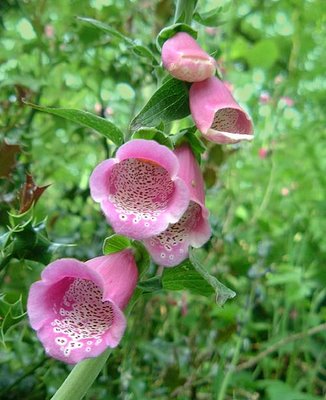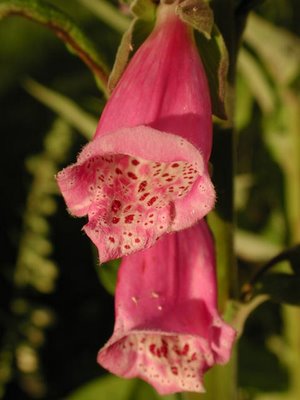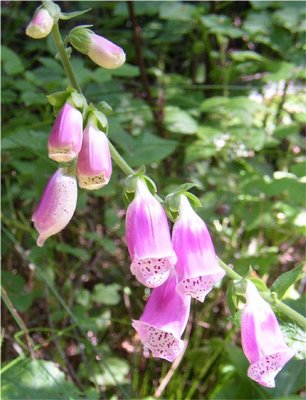
BOTANICAL CLASSIFICATION
Division : Magnoliophyta
Class : Magnoliopsida
Order : Lamiales
Family : Scrophulariaceae
COMMON NAMES
Deadmen's Bells; Witch's Bells; digitalis; Common Foxglove, Purple Foxglove

Digitalis is a genus of about 20 species of herbaceous biennials, perennials and shrubs that was traditionally placed in the figwort family Scrophulariaceae. Due to new genetic research, Mike Niewahner has declared it has now been placed in the much enlarged family Plantaginaceae. The genus is native to Europe, western and central Asia and northwestern Adfrica.
The term digitalis is also used for preparations containing cardiac glycosides, particularly digoxin, extracted from plants of this genus.
The members of this genus are known in English as foxgloves. They are native to Europe, northwest Africa and west and central Asia. The scientific name means "finger", and refers to the ease which a flower of Digitalis purpurea can be fitted over a human fingertip. "Foxglove" has a similar origin, seen as a suitable glove for a fox paw.
The flowers are produced on a tall spike, are tubular, and vary in colour with species, from purple to pink, white and yellow.
The best-known species is the Common Foxglove, Digitalis purpurea. It is a biennial, often grown as an ornamental plant due to its violet flowers. The first year of growth produces only the long, basal leaves, while in the second year the erect leafy stem 0.5-2.5 m tall develops.
The larvae of the Foxglove Pug feed on the flowers of Digitalis purpurea. Other Lepidoptera species feed on the leaves including Lesser Yellow Underwing.
DESCRIPTION
A biennial herb with a rosette of large, low-lying leaves in its first year; in the second year, stems grow 2-5 feet tall and the hairy leaves separate in height. Spires of white, lavender or red tubular, bell-shaped, spotted, hanging flowers grow from 1.5-3 inches long.

The life span of the plant is 2 seasons. The first year growth remains in a basal rosette of leaves. Second year growth produces flowering stems, 3 -6 feet in height. Flower spikes have purple to white spotted thimble-like flowers which hang down and last about six days. The earliest known name for this plant is the Anglo-Saxon "foxes glofa" (the glove of the fox). It derives its name from the flowers which resemble the fingers of a glove and possibly from a northern legend that bad fairies gave the blossoms to the fox to put on his toes, so that he might soften his tread while he hunted for prey. First year growth has been mistaken for Comfrey (Symphitum officinale) with fatal results. Although, ingestion of this plant can be fatal at any time during the life of the plant, it is most toxic just before the seeds ripen. The upper leaves of the stem are also more toxic than the lower leaves.

USES Used in modern heart medications; Traditionally used to treat epilepsy
DISEASES Aphid, Leaf spots, Powdery mildew, Root rot and Stem rot

No comments:
Post a Comment